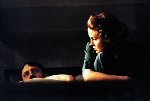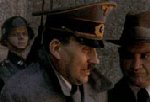 |
Vol 2, No 3
24 January 2000 |
|
|
The Elusive Hitler A Dialogue on Sokurov's Moloch Benjamin Halligan The arrival of Aleksandr Sokurov's Mat' i syn (Mother and Son, 1997) on the international festival circuit was one of the cinematic highlights of 1998; the one-time Russian dissident film-maker - and protégé of Andrei Tarkovsky - had arrived triumphantly on the world's screens. Praise for the film, "difficult" even by Art Cinema standards, was plentiful and as much from other film-makers as from critics. Musician Nick Cave's confessional piece "I Wept and Wept, from Start to Finish" (The Independent on Sunday, London, 29 March 1998) lent street kudos to the film and it was widely seen and discussed. The anticipation that greeted Sokurov's subsequent film - Moloch (1999) - still doing the rounds on the international film festivals - soon gave way to bafflement. News of the film's subject matter - Adolf Hitler - had given rise to the suggestion that Sokurov would present a meditation on European fascism from the dying moments of the century of fascism and the first full century of film. Moloch precipitated hopes of a study of the actual figure of Hitler and what drove him to such evil (characters are rarely more "present" than in Sokurov's films), a "meta-history" of the type identified in Mat' i syn and a film with mythic considerations (the term "Moloch" refers to a deity found in several ancient cultures - Greek, Israeli, Cathari - associated with the sacrifice of children.) Perhaps, Moloch would present the antidote to recent Hollywood excursions into this territory.
The reaction at the Cannes premiere and in the press was overwhelmingly negative. It seemed as if Sokurov (and his screenwriters, Yuri Aarabov and Marina Koreneva) had fallen foul of the usual problems of the representation of Fascism by European auteurs, such as Bernardo Bertolucci in Novecento (1976), Luchino Visconti in La Caduta degli Dei (The Damned, 1969) or Federico Fellini in Amarcord (1973), by resorting to caricature and the grotesque to visualise the nature of evil. In the midst of this unreality, Hitler-as-man is defiantly presented, a countercurrent to the kind of postmodern reading of Hitler-as-historical-figure expressed in Don DeLillo's novel White Noise (1985). However, Hitler's obsessions with defecation, his inane on-screen musings - at one point that Finnish people are all stupid because of the long periods of darkness they must endure and that Czech people have down-turned moustaches because of their lineage with the Mongolians - and even the concentration he pays to his soup, reduce this figure too to clownishness. After the film's reception in Cannes and at the London Film Festival, Sokurov was lumped in with Peter Greenaway as an auteur given to wilful mystification on screen, the courting of controversy (at one point, Hitler claims sincere ignorance of Auschwitz) and convoluted utterances in interviews and at press conferences. He could only add to his notoriety when he rejected the Grand Prix awarded to Moloch at the Sochi Film Festival in protest against the other winning films. The film, however, continues to demand a response (it played to full houses at the London Film Festival, for example) and, to this end, CER presents initial reactions to this difficult film in the form of a dialogue between Andrew J Horton, Benjamin Halligan and Donato Totaro. BLH: To me, the establishing shots of the castle, Hitler's cloud-capped mountain-top retreat, are the most immediately striking thing about the film. They recall similar shots in Fritz Lang's Metropolis (1926) and F W Murnau's Nosferatu (1922) - even Wim Wenders' Der Himmel über Berlin (Wings of Desire, 1987). AJH:
DT: The aesthetic did make me think of those German mountain films - but it seemed utterly contemporary - perhaps more in the blocking? The only director who comes close to the stylistic appropriation Sokurov is doing is a Canadian director most of the readers probably won't be familiar with, Guy Maddin. In his films Tales from the Gimli Hospital (1988), Archangel (1990) and Careful (1992). Maddin uses low-tech, in-camera effects (greased lenses, soft focus, iris effects, superimpositions), high contrast lighting (usually black & white) and manipulated soundtracks to recreate the textures of silent and early sound film history (German expressionism, kammerspiel, the mountain films, Universal horror); but with a decidely contemporary, postmodern feel BLH:
AJH: I was interested in the colours. It seemed to me that it was very much trying to recreate the tonal palette of the early colour films. The spatial architecture also suggests the cinematographic capabilities of an earlier age. Could not that scenery have been used in a 1960s James Bond movie? I don't know how much attention was displayed towards historical detail in the film, but it does seem that the mock-heroics of Nazism are being parodied via the mock-heroics of early colour films (maybe Sokurov is thinking here of early Russian colour films, such as Mikhail Chiaureli's Padenie Berlina [The Fall of Berlin, 1949], which, incidentally, also portrayed Hitler). There is certainly a large element of non-naturalism in Sokurov's films (the famous anamorphic effects, for example). I found this the clearest of Sokurov's films, but then maybe I am just getting accustomed to his visual language. BLH: I agree about the camp aspect of the film. Camp is often a way of approaching history in film and here it's as if Sokurov is revisiting "Fascist" aesthetics - alluding to German Romanticism and the reworking of that in Riefenstahl and the other film-makers of the Third Reich.
Maybe it is this that is unpalatable. DT: I think the central question/problem revolves around what sort of portrait of Hitler is being offered in cinematic terms: one of psychological realism, historical accuracy, projection and so on. BLH: The whole notion of the presentation of the very figure of Hitler is fascinating. To turn to such a figure after the anonymity of the protagonists of Mat' i syn is very bold. It's significant too that this film was made in 1999. Fascism is the one thing - and Hitler the one person - that defines the twentieth century. Even Spielberg has realised that!
It's as if all the thought and writing on Hitler has lifted him "out of time" - like the shots of the castle on the mountain - and it's proving near impossible to humanise him again. Hence these fragments of "human" scenes are all that remains. It's the same feeling of the distance and unknowability of history that can be found in the films of Federico Fellini and Walerian Borowczyk. Film is a medium perversely suited to this type of approach. AJH: In terms of portrayal of the man, the film relies on historians, such as Norman Stone, who have portrayed Hitler as pathetic and out of control rather than firm and domineering. As has been pointed out, he is portrayed in the film as having no knowledge of Auschwitz and those around him do not even want him to know of the place. The scenes where Hitler dances, pontificates on his theories about nettles in the Ukraine and falls asleep in company and then pretends he was always awake (amongst others) back up this view. BLH:
The film strikes me as genuinely unique in that it really turns the whole notion of "psychological realism" on its head. I have no idea if we're watching history or "projection" (Hitler's subjective point of view or, to use Pasolini's term, Free Indirect Subjectivity) or a point in-between. And the odd clips from newsreel footage problematises this further in a manner not dissimilar to Tarkovsky's Zerkalo (The Mirror, 1976) or Klimov's Idi i smotri (Come and See, 1985) - they rupture the aesthetic of the fictional representation of historic periods. In these ways, Sokurov is frustrating psychological and historical readings of the film and problematising the notion of the filmic recreation of historical events. AJH: Well, the primary philosophical influence seems to be Hannah Arendt, whose analysis of fascism centred around the concept of "the banality of evil". This emerges in the climax of Moloch (if we can talk of a Sokurov film having a climax), when Eva Braun declares the depth of her feeling for the Führer but at the same time says "You have always feared banality. The reason you became so severe." Braun even loves him, despite the fact he is a "big zero." Fascism
Wilhem Reich in his book The Mass Psychology of Fascism points out that this ideology acts as a form of "body armour." Sokurov shows the extent to which this armour exists and the extent to which it fails: the fact that the Nazis do not get on with each other, the fact that Hitler cannot form a real relationship with Braun and the fact that an expression of love under Fascism ultimately means nothing. As an essay in the "banality of evil," I think it is superb. But then again Arendt's ideas are not exactly new. Still, I found it a gripping film and one possibly designed to widen his audience and build on the success of Mat' i syn whilst trying not to alienate the faithful. Benjamin Halligan, 24 January 2000 Benjamin Halligan is a lecturer in film at the University of Wales, Aberystwyth. Andrew J Horton is the Culture Editor of Central Europe Review. Donato Totaro is the Editor of Offscreen.
|
|
![]()
Copyright © 2000 - Central Europe Review and Internet servis, a.s.
All Rights
Reserved





